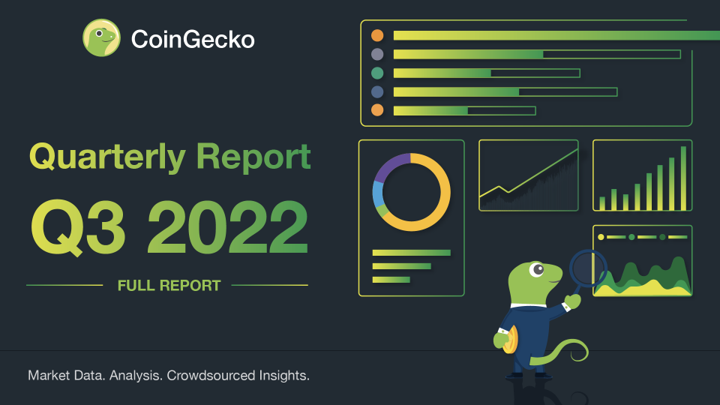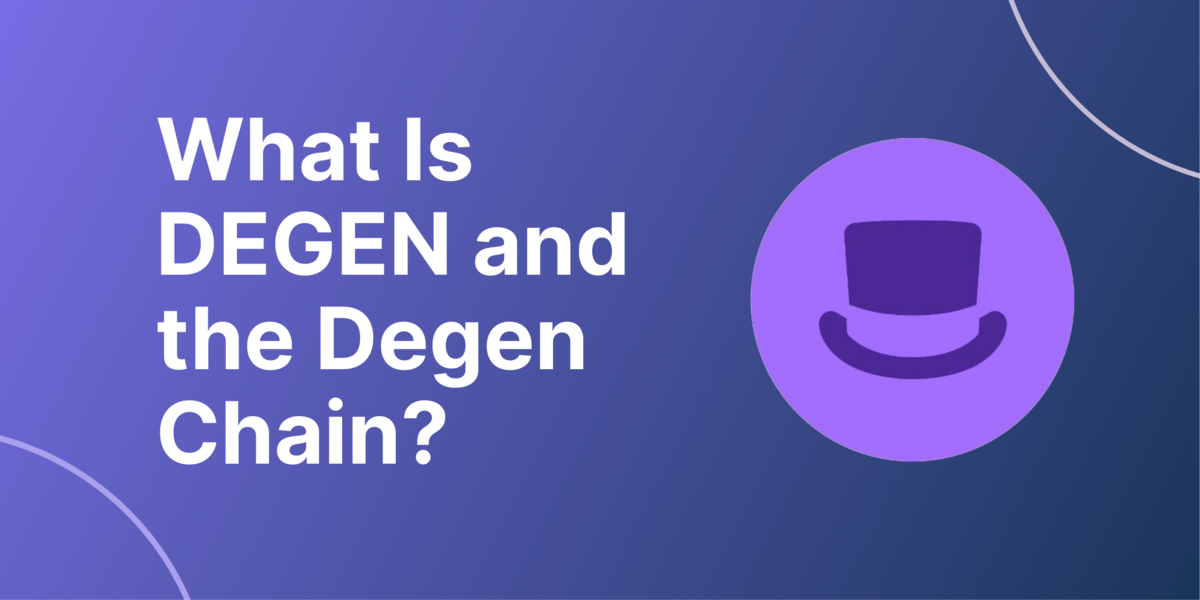
After the carnage in Q2 2022, Q3 was a relatively quiet quarter, with the market largely in consolidation mode despite mid-season bullish anticipation for the Merge. Total crypto market cap, BTC and ETH prices rounded up at where they started, at the end of Q3. NFTs, however, were not afforded such luxury, with QoQ trading volume plummeting by ~80% as interests in JPEGs continued to wane. Considering global geopolitical tensions and macroeconomic turmoil, the near-term outlook for crypto looks likely to remain challenging to say the least.
Our comprehensive Q3 2022 Cryptocurrency Report covers everything from the market landscape to analyzing Bitcoin and Ethereum, deep diving into the Decentralized Finance (DeFi) and Non-Fungible Token (NFT) ecosystem and reviewing the Centralized Exchanges (CEX) and Decentralized Exchanges (DEX) performance. Here are the main highlights of our report:
1. Total Crypto Market Cap Inched Higher in Q3 2022

Total Market Cap Change in Q3 2022
Total crypto market cap seems to have found its bottom when it hit a low of $875B on July 19. In Q3, it rallied up to ~$1.2T in August, before falling again to end the quarter at +6.5% or about ~$100B higher than at the end of Q2.
ALGO exited the Top 30, while ETC took its place, thanks to the Merge boost, clinching 23rd place. Some notable moves within the Top 30 include XRP overtaking BUSD at #6 (+60%), MATIC moving from #19 to #15 (+66%), and UNI which jumped from #27 to #18 (+129%).
Despite speculations of Bitcoin and the stock market, total crypto market cap correlation with the S&P 500 was still high at 0.85 in Q3 2022, although this was a slight decrease from the previous quarter (0.92). Similarly, total crypto market cap also moved pretty much in lockstep with BTC (0.9).
2. A Muted Quarter for Stablecoins

Top 15 Stablecoins Market Cap Change in Q3 2022
The market cap of the Top 15 stablecoins remained relatively similar to Q2’s performance, losing 3% or $4.7B in absolute terms.
The Top 5 stablecoins, Tether (USDT), USD Coin (USDC), Binance USD (BUSD), Dai (DAI) and Frax (FRAX), maintained their positions, having no new entrants nor changes to their order. There were notable movements in market cap within the Top 5, with USDC dropping 16% or $9B after the OFAC sanction of Tornado Cash. BUSD’s market cap grew the most, increasing by 18% or $3B due to inflows from USDC, as well as Binance’s announcement on BUSD auto-conversion.
USDT also saw a slight increase, possibly having absorbed some of the selloff of USDC. Meanwhile DAI and FRAX remained about the same in terms of market cap from Q2.
Outside of the Top 5, FEI dropped out of the Top 15, while USDX broke in. Some notable changes include TUSD (-27% or $0.32B), GUSD (+90% or $0.15B), USTC (-20% or $0.16B), and USDN (-84% or $0.65B).
3. USD Reigns Supreme
While Q3 was rather choppy for Bitcoin, it managed to outperform other asset classes except for the US Dollar Index (DXY). However from a YTD perspective, Bitcoin still experienced the largest loss of -58%, as compared to all other asset classes.
Bitcoin dipped hand-in-hand with US equities, but managed to largely recover compared to the equities market, ending Q3 with only a -1% change in price.

Fiat currencies have been performing poorly against the USD. The EUR and GBP have nearly hit parity against their US counterpart. Meanwhile, central banks across the world have mimicked the Federal Reserve in raising interest rates to stem the outflow while also combating inflation.
4. Bearish Macroeconomic Headwinds Overshadow Ethereum’s Successful Merge

ETH Price Return in Q3 2022
ETH finally saw a rally in early Q3, though failing to break the $2,000 resistance. It peaked at $1,982 in mid- August before tumbling back down.
Two weeks before the Merge, ETH started climbing again. Despite how the Merge was touted as the most bullish event for Ethereum, the upswing was brief.
A combination of high CPI, anticipation of an aggressive FOMC hike, and traders positioning themselves to ‘buy the rumor, sell the news’ meant the selloff started days before the Merge. With these bearish macroeconomic conditions dominating the market, general consensus is that the Merge was a ‘successful non-event’.
Although ETH is not a deflationary asset as yet, average daily net emission has dropped significantly by 95% post-Merge. While the Merge, in relation to the other Ethereum upgrades, was not meant to improve scalability, it’s interesting that average gas price has stayed low (~10 - 20 gwei) despite a small spike in on-chain transactions post-Merge.
Overall, ETH still rounded up Q3 with a +26% positive price return – a marked improvement over the first half of 2022, in spite of an anti-climatic price rally leading up to the Merge. That said, the YTD price return for ETH is still very much in the red at -64%.
5. DeFi Rebounds in Q3, with a ~31% QoQ Increase

Total DeFi Market Capitalization as of October 1, 2022
DeFi enjoyed a decent rebound in Q3 2022, as most sectors managed to stem the bleeding and then some. Overall, the DeFi market cap grew by ~31% QoQ. Even though Ethereum has plunged 33% to $1,330 from its quarterly high in mid-August, it is still up by 26% compared to Q2.
Besides maintaining its status as the largest constituent of DeFi, DEXs notched a significant increase in market share, rising 36.8% to $10.9B. This can be attributed to the uptick in trading volume and volatility for governance tokens of liquid staking protocols, largely driven by the Merge narrative. Notably, the liquid staking sector nearly tripled its market cap to $1.54B in Q3, and Lido, the market cap leader in that category, rose 264% to $1.60 within that period.
Although the fixed interest sector grew by an impressive 90%, largely due to the BarnBridge V2 launch, it is also the smallest, representing only 0.3% of the overall DeFi market.
6. NFT Winter is Here: -77% Fall in QoQ Trading Volume

Trading volume decrease from Q2 2022 to Q3 2022
The NFT market took a heavy hit in the past quarter, registering a -77% fall in total trading volume across the Top 5 NFT marketplaces, OpenSea, Magic Eden, LooksRare, X2Y2 and CryptoPunks.
September numbers show that ~85% of X2Y2’s volume potentially came from wash-trading, which would have given it the edge over OpenSea on the leaderboard. The same goes for LooksRare which, despite its already meager volume, is still apparently driven by ~87% wash trades.
MagicEden was the only NFT marketplace that saw growth in September, doubling its MoM volume and dominance while the rest of its competitors continued to slip. With its recent foray into Ethereum, as well as the headline-grabbing launch of y00ts, MagicEden (9% → 22%) has gained ground on OpenSea’s (90% → 60%) dominance in Q3. It remains to be seen if it can sustain the momentum.
Get the Full Scoop: CoinGecko's Q3 2022 Cryptocurrency Report
Want to deep dive further? Find our complete Q3 2022 Cryptocurrency Report below.
Like what you see? Sign up for our newsletter for daily crypto updates!
If you use these insights, we would appreciate a link credit to this report on CoinGecko. A link credit allows us to keep supplying you with future data-led content that you may find useful.

CoinGecko's editorial team comprises writers, editors, research analysts and cryptocurrency industry experts. We produce and update our articles regularly to provide the most complete, accurate and helpful information on all things cryptocurrencies. Follow the author on Twitter @coingecko






 Or check it out in the app stores
Or check it out in the app stores
